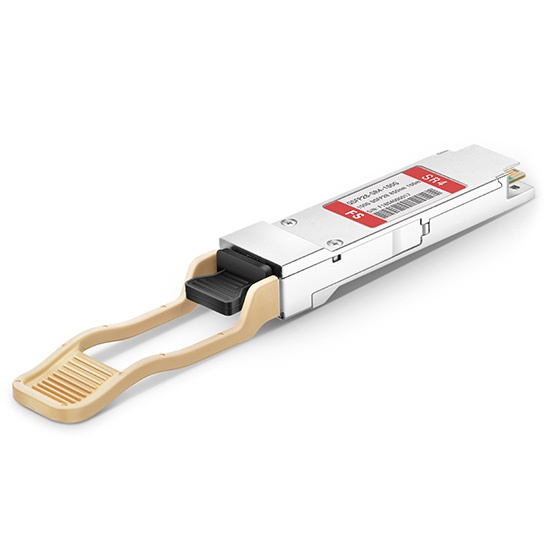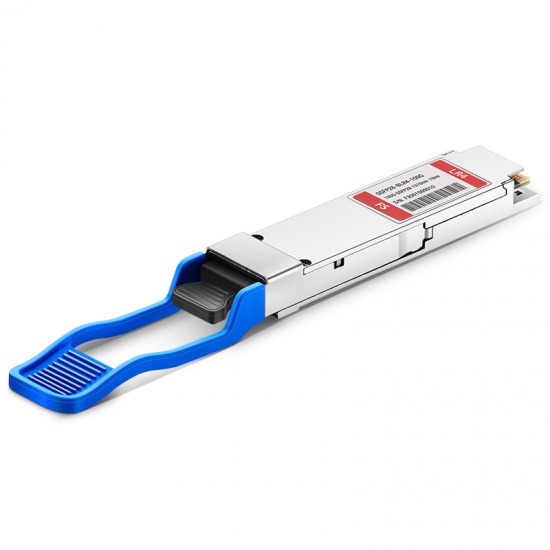With the thriving 100G market, QSFP28 has become the dominant form factor for 100G networks. The QSFP28 transceiver offers four channels of high-speed differential signals with data rates ranging from 25 Gbps up to potentially 40 Gbps, and meets 100 Gbps Ethernet (4×25 Gbps) and 100 Gbps 4X InfiniBand Enhanced Data Rate (EDR) requirements. As a world leader in IT and networking, Cisco 100G transceivers have been highly favored by many Ethernet users. Cisco 100G QSFP-100G-SM-SR and Cisco QSFP-100G-CWDM4-S are two different form factors of Cisco 100G optics. This article would give brief introduction to Cisco 100G QSFP-100G-SM-SR and Cisco QSFP-100G-CWDM4-S, and further analysis QSFP-100G-SM-SR Vs QSFP-100G-CWDM4-S.
Cisco 100G QSFP-100G-SM-SR
The maximum transmission distance of the Cisco QSFP-100G-SM-SR QSFP module is kilometers via a standard pair of G.652 singlemode fiber with duplex LC connectors. The 100 Gigabit Ethernet signal is carried over four wavelengths. Multiplexing and demultiplexing of the four wavelengths are managed within the device. The operating temperature range is from +10 to +60°C with an optical link budget of 4.2 decibels. This 4.2-decibel link budget offers the ability to support the loss from patch panels in the link in a data center environment. QSFP-100G-SM-SR is interoperable with QSFP-100G-CWDM4-S.
Cisco 100G QSFP-100G-CWDM4-S
As same as Cisco 100G QSFP-100G-SM-SR, Cisco 100G QSFP-100G-CWDM4-S supports link lengths of up to 2 kilometers as well. The QSFP-100G-CWDM4-S optical transceiver is for singlemode fiber. There are 4 CWDM-WDM lanes in the 12761-1331-nm wavelength window. This 100GBASE QSFP-100G-CWDM4-S Cisco 100G transceiver converts 4 input channels of 25Gb/s electrical data to 4 channels of CWDM optical signals and then multiplexes them into a single channel for 100Gb/s optical transmission. It uses a duplex LC connector on the optical interface and uses an MSA-compliant 38-pin edge type connector on electrical interface. This QSFP-100G-CWDM4-S Cisco 100G transceiver is equivalent to Cisco QSFP-100G-SM-SR.
QSFP-100G-SM-SR Vs QSFP-100G-CWDM4-S
From the above descriptions, it is obvious that the Cisco QSFP-100G-SM-SR is compatible with Cisco QSFP-100G-CWDM4-S 100G optical transceivers. They are used interoperably. And thus, they have many things in common.
Multiplexing and demultiplexing of the four wavelengths are managed within both Cisco 100G QSFP-100G-SM-SR Vs Cisco QSFP-100G-CWDM4-S. They convert 4 input channels of 25Gb/s electrical data to 4 channels of CWDM optical signals and then multiplexes them into a single channel for 100Gb/s optical transmission.They all use a standard pair of G.652singlemode fiber.
The transmission reach of both Cisco 100G QSFP-100G-SM-SR and Cisco QSFP-100G-CWDM4-S all can be up to 2 kilometers.
The original Cisco 100G QSFP-100G-SM-SR and Cisco QSFP-100G-CWDM4-S optical module is pricey, so nowadays many enterprises and data center workers would choose to buy Cisco compatible optical modules from third party vendor. For the price of QSFP-100G-SM-SR Vs QSFP-100G-CWDM4-S, they are identical at fs.com.
Conclusion
Through this article, we are clear that the QSFP-100G-SM-SR and QSFP-100G-CWDM4-S can be used interoperably. And they are totally identical at large extent. And thus, there are basically no difference on QSFP-100G-SM-SR Vs QSFP-100G-CWDM4-S. Nowadays, they have been applied to data center, high-performance computing networks, enterprise core and distribution layers, and service provider applications.




